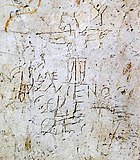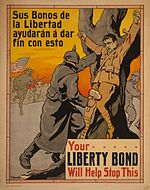This is an old revision of this page, as edited by Tryptofish (talk | contribs) at 23:48, 12 January 2010 (→Early depictions: provide cite). The present address (URL) is a permanent link to this revision, which may differ significantly from the current revision.
Revision as of 23:48, 12 January 2010 by Tryptofish (talk | contribs) (→Early depictions: provide cite)(diff) ← Previous revision | Latest revision (diff) | Newer revision → (diff)Crucifixion has appeared in art and popular culture from the era of the pagan Roman Empire. The crucifixion of Jesus has been depicted in religious art since the fourth century CE. In more modern times, crucifixion and crucifixes have appeared in film and television as well as in fine art, and depictions of other historical crucifixions have appeared as well as the crucifixion of Christ. Modern art and culture have also seen the rise of images of crucifixion being used to make statements unconnected with Christian iconography, or even just used for shock value.
Early depictions

The Alexamenos graffito, currently in the museum in the Palatine Hill, Rome, is a Roman graffito from the second century CE which depicts a man worshiping a crucified donkey. This graffito, though apparently meant an insult, is the earliest known pictorial representation of the crucifixion of Jesus. The text scrawled around the image reads Αλεξαμενος ϲεβετε θεον, which translates to "Alexamenos worshipping God" or some variant of this sentence.
Christian art
| This section needs expansion. You can help by adding to it. (November 2009) |
In the first three centuries CE, crucifixion was almost never depicted in art. Constantine I forbade crucifixion as a method of execution, and early church leaders regarded crucifixion with horror, and thus, as an unfit subject for artistic portrayal. Prior to the Middle Ages, early Christians preferred to focus on the "triumphant" Christ, rather than a dying one, because the concept of the risen Christ was so central to their faith.
Starting in the fourth century CE, crucifixion imagery began to appear in art. Early paintings tended to show the scene in stylized fashion, minimizing the appearance of suffering, so as to draw attention to the positive message of resurrection and faith, rather than to the physical realities of execution. In the Middle Ages, the worship of Christ changed, focusing on the details of the life and death of Jesus. Jesus was seen as a human being, capable of suffering. The first depictions of crucifixion displaying suffering are believed to have arisen in the Russian Orthodox church. By the Renaissance, a trend developed towards increasingly realistic representations of suffering.
 |
 |
 |
Modern art
Crucifixion has appeared repeatedly as a theme in many forms of modern art.
The surrealist Salvador Dali painted Crucifixion (Corpus Hypercubus), representing the cross as a hypercube. The sculpture Construction (Crucifixion): Homage to Mondrian, by Barbara Hepworth, stands on the grounds of Winchester Cathedral. Photographer Robert Mapplethorpe's 1975 self-portrait shows the artist, nude and smiling, posed as if crucified. In 1987 photographer Andres Serrano created Piss Christ, a controversial photograph that shows a small plastic crucifix submerged in a glass of the artist's urine, in which Serrano intended to depict sympathetically the abuse of Jesus by his executioners.
Other artists have used crucifixion imagery as a form of protest. In 1974, Chris Burden had himself crucified to a Volkswagen. Robert Cenedella painted a crucified Santa Claus as a protest against Christmas commercialization, displayed in the window of New York's Art Students League in December 1997. In August 2000, performance artist Sebastian Horsley had himself crucified without the use of any analgesics.
 |
 |
 |
Popular art

Crucifixion in popular art, as with Modern art, is sometimes used for its shock value, as for example in the WWI Liberty bond poster by Fernando Amorsolo, which depicts a German soldier nailing an American soldier, his arms outspread, to the trunk of a tree.
The cover art of Tupac Shakur's album The Don Killuminati: The 7 Day Theory features an image of Tupac being crucified on a cross. He stated that the image was not a mockery of Christ; rather, it showed how he was being "crucified" by the media. Multiple Marilyn Manson videos such as "I Don't Like The Drugs But The Drugs Like Me" and "Coma White" feature crucifixion imagery, often oddly staged in surreal modern or near modern day settings. The Norwegian black metal band Gorgoroth had several people on stage affixed to crosses to give the appearance of crucifixion at a now infamous concert in Krakow, and repeated this act in the music video for "Carving a Giant."
Crucifixion figures prominently in graphic novels from many cultures throughout the world. In particular, it has figured prominently in Japanese manga and anime. In manga iconography, crucifixes serve two purposes: as death symbols, and as symbols of justice. Japanese cultural awareness of crucifixion dates from the 16 century, when it began to be used for capital punishment in Japan. Most Japanese people regard crucifixion from a secular viewpoint, and producers of anime generally deny any religious motivation for crucifixion imagery. Instead, scholars trace the popular significance of crucifixion to Japanese views of the bombings of Hiroshima and Nagasaki. These crucifixion depictions evoke a sense of heroic transcendence and spiritual rebirth, without being specifically religious. Susan J. Napier writes that crucifixion imagery portrays "messianic figures offering revenge fantasies". Some Westerners find anime portrayals of crucifixion offensive, leading to suppression of crucifixion imagery from Fullmetal Alchemist and Sailor Moon. Referring to Western suppression of these images, Patrick Drazen wrote: "It's ironic that a symbol as potent as crucifixion should be edited out precisely because of that potency. After all, the way it's generally used in anime—when it's used at all—is in a manner Westerners can understand. It becomes a form of torture for someone who doesn't deserve it."
Film and television
Numerous movies have been produced which depict the crucifixion of Jesus. Some of these movies depict the crucifixion in its traditional sectarian form, while others intend to show a more historically accurate account. For example, Ben-Hur (1959), was probably the first movie to depict the nails being driven through Jesus' wrists, rather than his palms. Mel Gibson's controversial The Passion of the Christ (2004) depicted an extreme level of violence, but showed the nails being driven into Jesus' palms, as is traditional, with ropes supporting the wrists.
Monty Python's Life of Brian ends with a sequence in which several of the cast, including Brian, are crucified by the Romans. The film ends with them all singing the song "Always look on the bright side of life". In this sequence, the characters are not nailed to the crosses, but tied at the wrists to the crossbar, and are standing on smaller crosspieces at foot level.
Few films depict crucifixion outside of a Christian context. Spartacus (1960) depicts the mass crucifixions of rebellious slaves along the Appian Way after the Third Servile War.
Music
| This section needs expansion. You can help by adding to it. (December 2009) |
Classical music
Crucifixion has figured prominently in Easter oratorios and requiems.
Popular music
In 2006, singer Madonna caused controversy by opening a concert held near Vatican City with a mock crucifixion, complete with a Crown of Thorns.
See also
References
- ^ Viladesau, Richard (1992). The Word in and Out of Season. Paulist Press. p. 46. ISBN 0809136260.
- Walter Lowrie, Monuments of the Early Church, Macmillan, 1901, p. 238
- Dom Dunstan Adams, What is Prayer?, Gracewing Publishing, 1999, p. 48
- Father John J Pasquini, John J. Pasquini, True Christianity: The Catholic Way, iUniverse, 2003, p. 105
- Augustus John Cuthbert Hare, Walks in Rome, Volume 1, Adamant Media Corporation, 2005, p. 201
- Catholic Encyclopedia, The Ass (in Caricature of Christian Beliefs and Practices)
- The Crucifixion and Docetic Christology
- A Sociological Analysis of Graffiti
- Charles William King, Gnostics and their Remains, 1887, p. 433 note 12
- ^ Elizabeth A. Dreyer, The Cross in Christian Tradition: From Paul to Bonaventure, Paulist Press, 2001, pp. 21–22.
- ^ http://www.jstor.org/pss/3728859
- R. Kevin Seasoltz ,A Sense Of The Sacred: Theological Foundations Of Christian Architecture And Art, 2005, Continuum International Publishing Group, pp. 99–110.
- Encyclopaedia Britannica Online
- Irene Earls, Renaissance Art: A Topical Dictionary, 1987, Greenwood Press, p. 73.
- Self Portrait, 1975, by Robert Mapplethorpe
- Murray, Timothy (1993). Like a film: Ideological fantasy on screen, camera and canvas. Routlegde. p. 84. ISBN 0415077338.
- Heartney, Eleanor (1998). "A consecrated critic - profile of popular television art critic Sister Wendy Beckett". Art in America. Retrieved 2007-09-05.
{{cite journal}}: More than one of|work=and|journal=specified (help); Unknown parameter|month=ignored (help) - The agony and the ecstasy. The Observer, 26 May 2002
- ^ Broderick 2007, p. 35
- Stanley, Sarah (2009). "Drawing on God: Theology in Graphic Novels". Theological Librarianship. 2 (1): 83–88.
{{cite journal}}: Unknown parameter|month=ignored (help) - Drazen 2003, pp. 142–154
- Drazen 2003, p. 149
- Drazen 2003, p. 144
- Dolin, Alexander (Spring 2006). "Sacred Writings of East-Asian Religions in the Context of Comparative Cultural Studies" (PDF). Discourse: Learning and Teaching in Philosophical and Religious Studies. 5 (2): 63.
- Navok Rudranath, Jay; Jay Navok, Sushil K., Jonathan Mays (2005). Warriors of Legend (2nd ed.). North Charleston, S.C.: Booksurge LLC. pp. 126–27. ISBN 9781419608148. OCLC 61255404. http://books.google.com/books?id=cQ4PGtPYOugC
- Broderick, Michael (2007). "Superflat Eschatology: Renewal and Religion in Anime" (PDF). Animation Studies—Animated Dialogues: 29–45.
{{cite journal}}: Invalid|ref=harv(help) - Drazen 2003, pp. 155–168
- Broderick 2007, p. 32
- ^ Drazen, Patrick (2003). "Faith-Based: Christianity, Shinto, and Other Religions in Anime". [[Anime Explosion]]. Stone Bridge Press, LLC. pp. 142–43. ISBN 978-1880656723. OCLC 50898281.
{{cite book}}: Invalid|ref=harv(help); URL–wikilink conflict (help) - Daily Mail